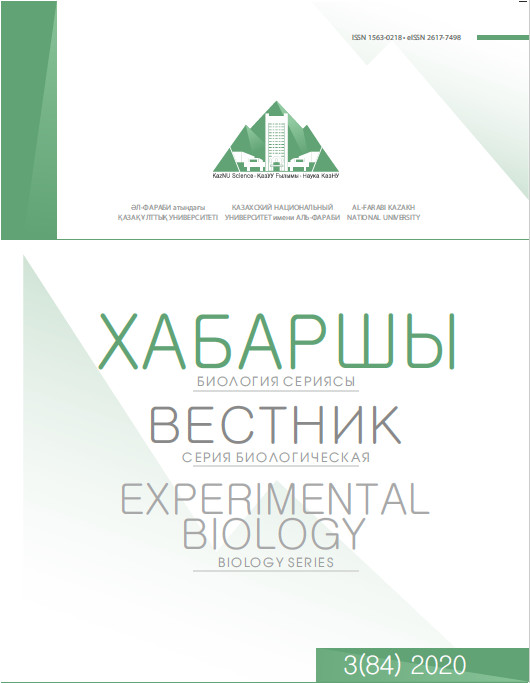Биохимические и анатомические исследования Seriphidium heptapotamicum (Asteraceae) в казахстане
DOI:
https://doi.org/10.26577/eb.2020.v84.i3.02Аннотация
В настоящее время изучение структуры и состава растений очень важно для медицины, парфюмерии, фермерских хозяйств и т.д. Seriphidium heptapotamicum (Poljak) Ling & Y.R. Ling. входит в раздел семейства сложноцветных. В этом исследовании обсуждаются биохимические и анатомические особенности. Согласно новым наблюдениям, предыдущее описание вида было дополнено дополнительной информацией. Анатомические исследования проводились на вегетативных органах Seriphidium heptapotamicum с использованием парафинового метода. Анатомия Seriphidium heptapotamicum не изучена. Анатомически, поперечное сечение корня имеет эпидермис в качестве защитной ткани во внешнем слое и эндодерма четко не видна. Стебли имеют толстый, хорошо развитый слой склеренхимы. Листья равносторонние. Для биохимического исследования эфирное масло было выделено из надземных частей Seriphidium heptapotamicum с использованием аппарата Кливенджера. Выход эфирного масла Seriphidium heptapotamicum составил 2,4%. Химический состав эфирного масла анализировали с помощью GC-FID и GC-MS одновременно. Химический состав эфирного масла зависит от коллекций. Эфирное масло состоит из 14 компонентов, в которых основными доминирующими компонентами были туйон-41,10%, 1,8-цинеол-22,84%, β-туйон-17,45% и камфора - 11,99%. Кроме того, в этом исследовании было получено содержание эфирного масла Seriphidium heptapotamicum.
Ключевые слова: Seriphidium heptapotamicum, Алтын-Эмель, эфирное масло, GC; GC-MS.
Библиографические ссылки
2 Amin S.M., Hassan H.M., El Gendy A.E.‐N.G., El‐Beih A.A., Mohamed T.A., Elshamy A.I., Bader A., Shams K.A., Mohammed R., Hegazy M.‐E.F. (2019). Comparative chemical study and antimicrobial activity of essential oils of three Artemisia species from Egypt and Saudi Arabia. Flavour and Fragrance Journal, 34: 450–459.
3 Asilbekova D.T., Bekker N.P., Chernenko T.V., Glushenkova A.I., Ul’chenko N.T. (2012). Lipids, Lipophilic Components and Essential Oils from Plant Sources. Springer Science+Business Media, LLC. 76-77.
4 Bercu R., Broască L. (2012). Histoanatomical features of Artemisia alba subsp. saxatilis (Willd.) P. Fourn. Annals of the Romanian Society for Cell Biology, 17(1): 278-280.
5 Bodoev N. V., Bazarova S. V., Pokrovsky L. M., Namzalov B. B., Tkachev A. B. (2000). The composition of essential oil of wormwood in the cold flora of Buryatia. Chemistry of plant raw materials, 3: 41-44.
6 Bora K.S., Sharma A. (2011). The genus Artemisia: a comprehensive review. Pharmaceutical Biology, 49 (1): 101-9.
7 Gilani S. A., Fujii Y., Sugano M., Watanabe K. N. (2010). Chemotypic variations and phytotoxic studies of essential oils of endemic medicinal plant Seriphidium kurramense from Pakistan. Journal of Medicinal Plants Research, 4 (4): 309-315.
8 Grudzinskaya L.M., Gemedzhiyeva N.G., Nelina N.V., Karzhaubekova ZH.ZH. (2014). Annotirovannyy spisok lekarstvennykh rasteniy Kazakhstana. Spravochnoye izdaniye, 20 (1): 220. (in Russian).
9 Hayat, M. Q., Ashraf, M., Khan, M. A., Yasmin, G., Shaheen, N., Jabeen, S. (2009). Phylogenetic relationships in Artemisia spp. (Asteraceae) based on distribution of foliar trichomes. International Journal of Agricultural and Biology 11, 553–558.
10 Hussain A., Hayat M.Q., Sahreen S., Bokhari Syed A.I. (2019). Unveiling the Foliar Epidermal Anatomical Characteristics of Artemisia L. (Asteraceae) from Northeast (Gilgit-Baltistan), Pakistan. International Journal of Agriculture and Biology, 21(3): 630-638.
11 Ivaschenko A.A., Grudzinskaya L.M., Gemedzhieva N.G., Jaime A., Teixeira da Silva, Ryabushkina N.A. (2006). Genetic Resources of Kazakhstan Flora: Experience, Basic Targets and Methods for Conservation of Flowering Plants. Floriculture, Ornamental and Plant Biotechnology, 12: 583-584.
12 Janaćković P., Gavrilović M., Rančić D., Dajić Stevanović Z., Giweli A. A., Marin, P.D. (2019). Comparative anatomical investigation of Artemisia L. (Anthemideae, Asteraceae) species in view of taxonomy. Brazilian Journal of Botany, 42:135–147.
13 Johansen D. A. (1944). Plant microtechnique. McGraw-Hill, New-York, 523.
14 Kurşat M., Civelek Ş., Türkoğlu İ., Tabur S., Gür N. (2015). A new species of subgenus Seriphidium of Artemisia L. (Asteraceae) from Turkey. Turkish Journal of Botany, 39: 88-95.
15 Ling Y., Ling Y. R. (1988). The Chinese Seriphidium (Bess.) Poljak. The classification, distribution and application of Seriphidium (Bess.) Poljak in China.Bulletin of Botanical Research, Harbin. 8 (3): 119.
16 Nofal S.M., Mahmoud S.S., Ramadan A., Soliman G.A. Fawzy R. (2009). Anti-Diabetic Effect of Artemisia judaica Extracts. Research Journal of Medicine and Medical Sciences, 4(1): 42-48.
17 Sefidkon F., Jalili L. A., Mirhaji T. (2002). Essential oil composition of three Artemisia spp. from Iran. Flavour and Fragrance Journal, 17: 150 – 152.
18 Shaimerdenova Zh. R., Makubayeva A. I., Özek T., Özek G., Süleyman Y. G.,Atazhanova A., Adekenov S.M. (2018). Chemical composition of essential oils from Artemisia glabella Kar. et Kir. and Artemisia rupestris L. obtained by different extraction methods, Natural Volatiles and Essential Oils,5 (2): 1-9.
19 Tan, R.X., Zheng, W.F., Tang H.Q. (1998). Biologically active substances from the genus Artemisia. Planta Med. 64: 295–302.
20 The Plant List: Compositae (2016). Royal Botanic Gardens Kew and Missouri Botanic Garden. Retrieved18.
21 Valles J., Garnatje T., Garcia S., Sanz M., Korobkov A. A. (2005). Chromosome numbers in the tribes Anthemideae and Inuleae (Asteraceae). Botanical Journal of the Linnean Society. 148: 77-85.
22 Valles J., McArthur E. D. (2001). Artemisia systematics and phylogeny: Cytogenetic and molecular insights. Shrubland Ecosystem Genetics and Biodiversity: Proceedings, 67–74.
23 Velikorodov A. V., Morozova L. V., Pilipenko V. N., Kovalev V. B. (2011). The chemical composition of the essential oil of four endemic species of wormwood in the Astrakhan region: Artemisia lerchiana, Artemisia santonica, Artemisia arenariaand Artemisia austriaca. Chemistry of plant raw materials, 4: 115-120.
24 Zhang Zh., Pang X., Guo S., Cao J., Wang Y., Chen Zh., Feng Y., Lei N., Du Sh. (2019). Insecticidal Activity of Artemisia frigida Willd. Essential Oil and Its Constituents Against Three Stored Product Insects. Records of Natural Products, 13 (2): 176-181.
25 Zhang L.-B., Chang J.-J., Guo,L.-M. Lv, J.-L. (2018). Triterpenoids with α-glucosidase inhibitory activity from Artemisia argyi. Journal of Asian Natural Products Research, 20 (12): 1101-1193.



